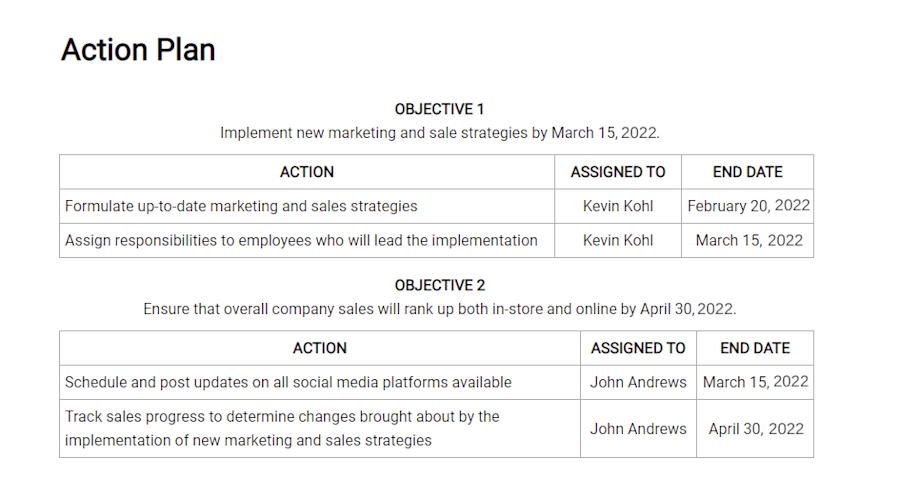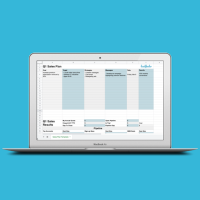A strong sales plan can turbo-boost your sales and marketing strategies. However, they aren’t necessarily much fun to write.
Sales plan samples and templates abound online, but there’s no need to get lost in the weeds. Writing a B2B sales plan doesn’t need to be complicated, and if you’re struggling to write a productive B2B sales plan (or one doesn't put your salespeople to sleep), you’re in the right place.
In this article, we share what a sales plan is, why it’s so important for you to be using one, and when and how you should implement yours. Plus, we also share seven simple steps for creating your own successful sales plan or you can download the Leadfeeder B2B sales business plan template if you’re feeling lazy. We can guarantee that it’s a winner!
Free sales plan template
A B2B sales plan is more than a list of corporate goals your team barely glances at while entering the office.
It’s a detailed, custom playbook for sales success.
It unites your team, resources, and efforts under realistic objectives.
It creates the magic behind successful businesses: sales and revenue.
If you’re serious about generating leads and sales, invest the time into creating one. To help get you started, I made this sales plan template for you.

What is a sales plan?
A sales plan is a strategic document that outlines specific steps for increasing sales. But, it's more than a collection of sales goals and shallow steps.
It lists the “who, what, where, and why” of your sales strategy and explains who handles certain operations at different milestones.
When done right, it’s the path to a well-oiled B2B sales machine that generates revenue.
So, where does a B2B sales plan template come into play?
A sales plan template provides an outline for a sales plan. It makes it easier to describe your sales objectives, target audience, and the specific steps, strategies, and tactics your business will use to hit sales and revenue goals.
Why is a B2B sales plan template important?
A sales template makes it easier to create an effective sales plan—which makes driving revenue attainable.
Here are a few additional reasons why creating a killer sales strategy template is crucial to business growth.
Identifying potential problems
Writing your B2B sales plan ensures your goals are realistic and achievable, and it helps you objectively compare your resources to the targets you’re trying to hit.
Identifying a problem allows you to adjust your strategy and goals accordingly.
Let’s say your top priority is landing 50%more enterprise leads by next year’s second quarter.
How do you do this?
You might decide to ramp up your account-based B2B marketing (ABM) game.
However, after reviewing your B2B sales plan, you realize that you don’t have the employee bandwidth or budget to focus on ABM.
Instead, you opt to focus on scoring and qualifying leads to improve lead quality.
You’ve now saved your company precious time and money—and found an alternate way to reach the same goal.
Increasing motivation
Who knew that creating a sales plan could increase motivation?
According to a 2022 pwc study, people who set at least four goals per week are 34% more likely to hit their KPI targets.
Writing and visualizing goals boosts motivation to take action by helping store them in our long-term memory.
This means something as simple as keeping your sales plan in plain sight can breathe a sense of purpose into your team’s daily activities.
And, a sense of purpose boosts morale and job satisfaction, as reps can see how their individual efforts help the whole team to strive for a common goal.
By outlining the team’s roles and responsibilities in your plan, you’ll also see increased accountability and a reduction in task duplication.
Setting goals
The idea of a sales plan is to provide clear objectives and a roadmap for reaching them. Without having goals in place, it’s impossible to know what you’re aiming for or how close you are to achieving that aim.
The sales plan helps you to communicate your goals, ensuring that everyone understands what you’re trying to achieve and why it’s important.
It outlines a strategic direction, offers actionable steps for reps to take, and helps you allocate resources properly.
In your plan, you can ensure that all goals are realistic, measurable, and time-bound.
You can base them around things like total addressable market and available resources, as well as results from previous years.
A sales plan that includes input from all stakeholders will reflect specific goals across the organization, such as customer success, product development, and financial health.
Uniting your teams
A study of sales and marketing employees found that the biggest threat to productivity is a misalignment between sales and marketing goals.
Not only is it demotivating, but it also forces sales reps to work harder and offer extra incentives (they otherwise wouldn’t need to provide) to close deals.
Then, in turn, extra incentives are a marketing nightmare—the circle of misalignment continues.
Sales and marketing are notorious for their adversarial relationship. And, no, a sales plan won’t overcome the beef between the two teams—not by itself anyway.
Working on project management together, let's say for a sales and digital marketing campaign, is a start for both teams to get good visibility of what is being planned. Getting everyone on the same page and being transparent can help unite them towards a common goal.
Predicting revenue
Being able to predict revenue is hugely valuable, as it helps you to make informed decisions for the future of the business.
When you can do this, it becomes a lot easier to create a realistic budget and make strategic investments.
Your sales plan includes information about past and current results, so you can create accurate sales forecasts.
For example, looking at past performance shows you how much your team is likely to sell in the upcoming quarter. You can also predict likely costs by assessing your current resources.
Because the sales plan contains details about target audiences, such as website visitor tracking data, and market conditions, you can factor these aspects into your predictions.
Decreasing expenses
As we mentioned, a sales plan helps you allocate resources effectively—which reduces waste and saves money. You can easily see your team structure and avoid hiring too many reps to cover a small territory.
By including data on customer profiles, the plan also keeps you laser-focused on high-quality leads. This leads to higher conversion rates with no resources wasted on the wrong leads.
Plus, measuring and reviewing metrics allows you to identify inefficiencies or campaigns that aren’t bringing in enough revenue.
A sales plan increases team motivation and provides a clear path toward meeting targets, so reps are more likely to perform well.
Increased motivation means they’re less likely to quit, too. And, that reduced turnover saves you the costs of acquisition, onboarding, and training.
When should you use sales plans?
There are many sales plan formats for different scenarios, which we’ll look at in the next section. But here are several signs that indicate the need for a sales plan:
If you lack a sales plan
If you don’t have a sales plan in place at all (really?) then it’s about time you did! And if you only have a template for a sales plan that was put together ages ago, it’ll definitely need updating.
If productivity is poor
If your reps are not as productive as they should be or the team dynamic isn’t working well, then a revised sales plan will enable you to find ways to improve and restructure.
If conversion rates are low
Are conversions falling short of your targets? A sales plan will help you to widen your target audience and outline strategies to segment and nurture prospects across the sales and marketing teams.
If you’re launching a new product
If you’re considering launching a new product or service, you’ll definitely need a strong sales plan that’s in alignment with your marketing team.
If circumstances have changed
Your organization might be expanding into new regions, or market conditions may have evolved over time. If any of the variables included in your sales plan have changed, you will need to update it.
Popular sales plan examples
In the next section, we'll cover how to create a functional sales template. But first, let's look at a few sample sales plans. You might notice common themes you'll want to use on your own.
The one-page sales plan
Your sales plan doesn’t need to delve into exhaustive detail. If you’re an agile small business, a one-page sales plan template will help you hit the ground running and lead your small team.
The idea is simple: keep things short and sweet while making sure the most important elements are present and correct.

A one-page template can cover any range of time, but consider a weekly sales plan template if you have a shorter, transactional sales cycle. Plus, a shorter length could help motivate your team if you’re just starting out with sales plans—meeting goals quickly leads to positive sentiment.
The 30-60-90 day sales plan template
The 30-60-90 day template is a standard choice for most teams. It helps you write a sales plan that covers short, medium, and long-term goals.
Here’s the gist of it: create one goal for the 30-day mark, one for the 60-day mark, and another for the 90-day mark. This sets a realistic pace for achieving your objectives.
It’s ideal for tracking the progress of new sales reps and giving them milestones to work towards. But, it’s also handy for creating achievable sales goals when you’re starting a new business, product, or service.
You may find that you hit each goal before the timeframe (or the opposite), so use it as a foundation and amend your goals as needed.

The 90-day sales plan template
If you have a product that requires demos, meetings, and runs through multiple decision-makers, using a 90-day sales plan for your long sales cycles is a good idea.
This type of plan takes the last section of the 30-60-90 plan and only focuses on meeting the long-term goal. Essentially, you’re giving your employees three months to achieve a set objective, the idea being that this longer timeframe gives them greater flexibility. Use those 90 days to encourage reps to make improvements. Now is the time to refine and innovate.

The new product sales plan
When you’re launching a new product or service—or adding extra features to an existing one—you’ll need a specific sales plan.
Think of it as a roadmap that the team needs to follow to guarantee the launch is successful and generates revenue. This will involve conducting market research and analyzing the competition.
You’ll also need a unique value proposition and new content for the sales and marketing teams to use when pitching to leads.
The market expansion plan
Expanding into a new market or territory? Use this plan to nail the logistics.
A market expansion plan lays out a few key factors: how you’ll approach sales for your new target audience, what tasks you need to tick off before expanding, and specific target metrics to use.
Include a competitor analysis and outline the costs involved to help you pinpoint a pricing strategy. If you’re going to be selling overseas, keep in mind that you might need to factor in time zones and cultural differences.
The marketing-alignment sales plan
Here’s an example of a sales plan template for organizations that haven’t yet aligned their sales and marketing departments.
It involves coming up with ideal customer profiles and buyer personas before aligning sales pitches with marketing messaging.
The plan gets both teams on the same page and avoids the risk of task duplication or misunderstandings. Make sure to be extra clear about roles and responsibilities.
The territory sales plan
Territory sales plans don’t just split up territories according to geography—they segment target customers by categories that are relevant to your business.
For example, if you’re selling web design software, you might use a SaaS sales plan template to target very small businesses with basic websites or traditional companies just looking to move online.
You’ll then match reps to customer groups, depending on which rep has the most relevant skills for that territory.
How to write a B2B sales plan template that drives revenue
Your main goal should be to distill your overall business goals into actionable sales objectives, milestones, strategies, and tactics.
This means your B2B sales plan template should—at the very least—include:
Target customers and ideal customer profiles
Role and responsibilities in your team
Revenue goals and sales objectives
Budget and resources
Challenges and obstacles
Pricing
Promotions
Key strategies and tactics
Deadlines, milestones, and review periods
To turn that information into a powerful B2B sales plan, follow these steps.
Step 1. Outline specific revenue and sales goals
In this step, having a birds-eye view of the sales plan is key. Within the revenue and sales goals, you should think about the conversion points along the sales funnel.
Making note of the points within the funnel that transition the potential customer from phase to phase down the funnel is useful as those will be focus points in the overall sales plan. If you’re aware of the conversion points, finding bottlenecks and optimizing the process is easier.
A Leadfeeder example of noting conversion points within the funnel would be:
Touched
Connected
Demo booked
Demo completed
Offer sent
Purchased
If the Leadfeeder sales team was having issues closing or meeting their targets, they would not only take a look at their revenue and sales goals, but they would also check on each conversion point to see where the disconnect was happening.
On a granular level, B2B sales goals should be anchored to revenue or volume targets.
For example, your goal might be a revenue target of $30k in annual recurring revenue (ARR) by the final quarter.
Using a volume target might mean 18 new customers per month or 200 sales by the final quarter.
When creating a strong B2B sales plan, you'll want to use both. That gives you more data to play with.
If you have to pick one metric in your sales plan over another, consider your:
Available resources (staff, budget, data)
Market
Priorities
Product type (SaaS, agency, physical retailer, etc.)
It’s easy to succumb to wishful thinking at this step. So review your goals against your resources to ensure they’re realistic.
Setting goals you’re sure to miss isn’t fun for anyone on the team and creates a crying wolf situation over time.
Step 2. Outline your mission and B2B sales plan objectives
Hopefully, you already have your mission and vision statements on paper. If so, grab them. (If not, now is the time!)
Then write down what you aim to achieve with the sales plan.
It doesn’t have to be lengthy Shakespearean prose that draws applause. This is just a summary of what’s ahead and why it’s included in your sales plan; that’s it.
Include a brief history of the business, too, if possible. This provides context as the plan matures in detail and complexity.
For example:
Leadfeeder's mission is to help marketing and sales professionals identify site visitors, transform their traffic into qualified leads, and connect to key decision-makers.
Our goals are to obtain 18 new customers per month, 200 sales by the final quarter, with a final revenue increase of 30%.
This sales strategy plan will cover how we plan to increase salesperson efficiency and test new marketing strategies.
Step 3. Map out key sales plan milestones, deadlines, and review periods
This is where we get into the details. Deadlines, milestones, and review periods are a key part of your sales plan template.
Your third step is to tie sales and revenue targets to 30-60-90 day goals and set a schedule to review performance with your team.
This gives your plan teeth and signals when you’re falling behind quota so you can stay on track.
Step 4. Add an ideal client profile to your B2B sales plan
An ICP is a strict definition of an ideal customer.
Including your ICP in your sales plan helps align sales and marketing strategy. It gives insight into what lead generation approach to use.
Let’s say you’re a SaaS company that offers analytical tools to digital marketers. And some of your customers are freelancers and in-house teams.
But, large 50+ employee agencies who buy premium subscriptions are your ideal clients.
And, according to your historical sales data, the best way to reach them is through account-based marketing.
You can now invest in ABM tools like Leadfeeder and training for reps without wondering if it will generate a return.
Here’s proof—AlertOps uses Leadfeeder to automatically qualify website visitors with over 100 employees. Then, Leadfeeder sends those leads to Pipedrive and the AlertOps reps call on every potential customer.
Within just 30 days of using Leadfeeder with the Pipedrive integration, AlertOps was able to increase their sales demo rate by 700%. BAM. 💥
Step 5. Take stock of your sales CRM, tools, and budget
Ever try shoveling snow with a garden spade? (I hope not.)
The point is, using the wrong tool just makes your life harder.
If you're attempting to close deals without the right tools and resources for the job, you will get frustrated and, possibly, fail.
That’s why a summary of your main CRM software, sales tools, budget, and any other predictable expense should be included in your sales plan.
This will include things like:
Budget allocation
Specific tools and resources
What CRM will be used
Salary, commission, and incentives
Training
Make sure your team has access to the tools it needs to reach your goals.
Step 6. Delegate roles and responsibilities
So now you know what you want to do, you've mapped out a specific sales strategy plan, and you've made sure you have the tools to get the job done.
But who is going to do what?
Next, list the members of your team and the roles they will play in reaching your goals.
Think about:
Who is responsible for prospecting or warming leads up?
Who will handle meetings and appointments?
Who will be presenting product demos/training?
Then, add those answers to deadlines, milestones, and KPIs.
If your sales strategy requires indirect sales activities — like creating content or developing sales material — write that into your sales plan template, too.
Step 7. Bring your B2B sales plan template to life with an action plan
This is where the rubber meets the road.
Creating an action plan brings your sales plan to life by explaining exactly how you’ll meet your objectives.
For example, if your objective is:
Increase premium subscriptions by 20% this quarter, and raise monthly recurring revenue by 2%.
Your plan might look like this:
Create 3 case studies that convey the benefits of a premium subscription.
Use paid ads and content marketing to promote premium subscriptions.
Create a lead scoring system to focus on leads with high purchase intent.
Bump referral discounts to premium subscriptions up by 10%.
Make sure to link these action points to resources, deadlines, and milestones.
Who is going to do what? Who will be responsible for managing each project?
Make this part as detailed as possible so you know exactly how to move forward.
Tips for creating the best sales plan
Now for a few handy hints on how to design the best sales plan for any scenario:
Analyze the competition: It’s always worth keeping one eye on competitors to see what they’re up to and what you can learn from them—as well as what not to do! Research their strategies and tactics as well as general industry trends.
Encourage collaboration: For a truly comprehensive plan, all departments—not just sales and marketing—should provide input and brainstorm ideas. That way, you can make sure the sales plan outline addresses everyone’s needs.
Set individual targets: Consider the skills and experience of your sales team and factor that into their goals and targets. New reps won’t be able to replicate the performance of someone who’s been doing the job for years, so they need lower quotas to keep them motivated. You should also talk to all sales reps about their challenges.
Celebrate wins: Another way to improve morale is to recognize and reward successes and milestones. This makes reps feel valued and encourages the whole team to aim higher.
Keep measuring: Keep a close eye on your sales metrics and KPIs to check progress toward your goals. Monitoring these will reveal areas for improvement, including high and low performers. Measurement also ensures accountability and continuous improvement.
Use the right tools: Software helps you to create (and stick to) a great sales plan. You should use sales planning templates and tools to automate workflows, a CRM to keep all sales data in one place, and web analytics tools to identify new leads to target.
How Leadfeeder can help you achieve sales plan success
Now that we’ve covered sales plans from every angle, you should be ready to construct your own. Follow our top tips and choose a plan that works for your business and current situation—there’s no use using a new product plan if you don’t have a new product!
If you’re still unsure, simply download our free sales plan template. It’s easy to make the template your own and even test out different versions.
You'll be closing deals in no time.
Note: If your sales plan counts on quality leads, look no further than Leadfeeder. Sign up for a 14-day free Leadfeeder trial today.
Sales plan FAQs
How to write a sales plan for B2B
Start by thinking about what you need to achieve in the coming months or years and clearly define the key objectives with a specific timeframe and relevant metrics to measure them. Research your audiences, competitors, and industry trends, and pair this with your own sales data. This information will tell you how to prepare a sales plan with actionable steps.
What should my sales plan include?
There’s no definitive sales plan format, but a successful sales plan usually starts with a brief mission statement and a list of goals. Identify your target market, ideal customer profile, and market conditions. Describe your available resources and set a realistic budget. Then outline your strategies for prospecting, with an action plan and clear roles and responsibilities.
How can you measure the success of a sales plan?
First, define what success looks like for your team. Once you’ve set goals, decide on the metrics you’ll use to track progress. For individual performance, look at things like number of calls made, conversion rates, and average deal size.
Sales cycle length is also a key metric. Measure total revenue and pipeline value as well as win rate and employee retention rate. The metrics will indicate how successful your sales plan is and when it needs to be reviewed.
How often should you update your sales plan?
Circumstances evolve over time—that includes market conditions, team structures, and new product launches. Update your sales plan any time there’s a change or if your metrics show that things have gone off track. Review progress at least once a month and adjust it if needed. It’s important to build flexibility into the plan from the outset to allow for unexpected changes.
Now that you're here
Leadfeeder is a tool that shows you companies that visit your website. Leadfeeder generates new leads, offers insight on your customers and can help you increase your marketing ROI.
If you liked this blog post, you'll probably love Leadfeeder, too.
Sign up







